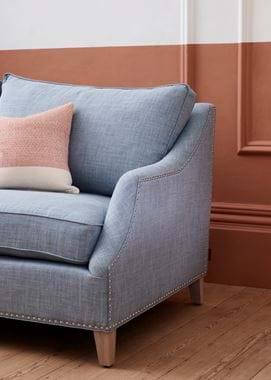The price of value
The price of value
How do you establish something’s worth? Interiors journalist Giles Kime says it’s got nothing to do with the price.
We own a sofa that once belonged to my great-grandfather that we use every day. I’m sitting on it now. Neither its neat, elegant proportions nor its venerable old age compromise its comfort; whether I’m sitting or sprawling, it has a magical ability to offer support just where required, even while I’m balancing a laptop on my knee.
It’s an heirloom that just keeps on giving – first to my grandmother, then my mother, and now to us. With each generation, there's been a new cover, and I can remember its different incarnations – my grandmother chose wool, my mother opted for a jaunty stripe, and we upholstered it in a delicious chocolatey velvet.
I’m not aware that it has ever required any structural repair, but if it was a poorly made modern sofa, this wouldn’t be an option. I’m also not aware how much my great-grandfather paid for our sofa. He wasn’t a rich man, but whatever the figure, it was an investment that has reaped pretty good returns and one that highlights deficiencies in so much modern furniture, as well as our own dwindling expectations of what furniture should be.
Now's a time that's critical for the way we perceive value in everything; with the rising cost of materials, wages and transport, do we lower, maintain, or raise our standards? Time and careful consideration might cost money, but a trip to your local dump offers a startling insight into the reality of lesser quality furniture with a bad case of inbuilt obsolescence thanks to peeling veneer, substandard materials, and staples rather than robust joints and stitching.
It’s possible to do so much better – and, thankfully, some manufacturers still do. Of course, everyone has to cut their cloth according to their means. Yet of all the financial savings anyone might have to make, whether on holidays or cars, furniture is perhaps the one that will have the greatest impact on our daily lives, long after this current economic turbulence has been forgotten.
As we’ve discovered, a beautifully made, carefully designed, comfortable piece of furniture with a capacity to last a hundred years is the best value piece of furniture you’ll ever buy.
How to: spot a good buy
When it comes to buying furniture well, there are a few things to look out for whether you’re buying new or antique.
Materials
- Look for furniture made from solid wood or over six-nine layer plywood for durability. Avoid thin ply, particleboard or fibreboard.
- If you choose a solid wood with a veneer, be aware that the veneer won’t withstand many rounds of sanding down if blemishes occur. Thicker veneers run the risk of peeling off.
- Check for deep knots in the wood which might indicate future splits or possible cracks.
Build
- Look for dovetail or mortise and tenon joints and reinforced corner blocks over anything
constructed with staples, nails or visible glue. - Ensure that any drawers glide smoothy, and try to avoid wood-on-wood sliding.
- Investigate any hinges to ensure they’re tight, have no rough edges, and are not rusted or bent.
- Check the frame for creaks or wobbles by pressing down on each corner on a level surface.
Upholstery
- In seating, look for coil or serpentine springs that are positioned close together and have some resistance when squashed, and avoid anything where the springs are more than a few inches apart.
- Look at the alignment of fabric patterns, and consider opting for more neutral colours for larger pieces of furniture as they will stay in favour longer. You can always introduce colour and pattern through smaller pieces.
Giles Kime is executive editor of Country Life magazine and author of four books including Nina Campbell Decoration and Homes & Gardens Decorating. He has most recently co-authored The Evolution of Home with Neptune's creative founder and founder of interior design studio Sims Hilditch, Emma Sims-Hilditch.






